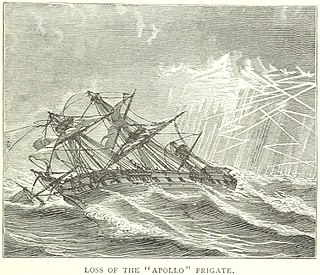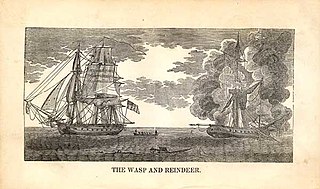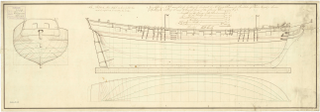HMS York was a 64-gun third rate ship of the line of the Royal Navy, launched on 24 March 1796. She served briefly in the West Indies where she captured numerous small vessels. She was wrecked in 1804.

HMS Apollo, the fourth ship of the Royal Navy to be named for the Greek god Apollo, was a fifth-rate frigate of a nominal 36 guns. She was the name ship of the Apollo-class frigates. Apollo was launched in 1799, and wrecked with heavy loss of life in 1804.

HMS Reindeer was a Royal Navy 18-gun Cruizer-class brig-sloop of the Royal Navy, built by Samuel & Daniel Brent at Rotherhithe and was launched in 1804. She was built of fir, which made for more rapid construction at the expense of durability. Reindeer fought in the Napoleonic Wars before succumbing in 1814 to the guns of USS Wasp during the War of 1812.

HMS Lark was a 16-gun ship sloop of the Cormorant class, launched in 1794 at Northfleet. She served primarily in the Caribbean, where she took a number of prizes, some after quite intensive action. Lark foundered off San Domingo in August 1809, with the loss of her captain and almost all her crew.

HMS Ferret was a Royal Navy Cruizer-class brig-sloop built by Benjamin Tanner at Dartmouth and launched in 1806, 19 months late. She served on the Jamaica, Halifax, and Leith stations during which time she took three privateers as prizes before she was wrecked in 1813.
HMS Pike was a Royal Navy Ballahoo-class schooner of four 12-pounder carronades and a crew of 20. The prime contractor for the vessel was Goodrich & Co., in Bermuda, and she was launched in 1804. She captured one 10-gun enemy vessel before being herself captured, and recaptured.

HMS Haddock was a Royal Navy schooner of four 12-pounder carronades and a crew of 20. The prime contractor for the vessel was Goodrich & Co., in Bermuda, and she was launched in 1805.
On Thursday 21st inst launched off the stocks at Mr Isaac Skinner's shipyard his Majesty's Schooner "Haddock". The above schooner is said to be the completest vessel ever built in Bermuda
HMS Nimble was a Royal Navy 5-gun schooner-of-war. She was employed in anti-slave trade patrol from 1826 until 1834, when she was wrecked on a reef with the loss of 70 Africans who had been rescued from a slave ship.

HMS Monkey was a schooner of the British Royal Navy assigned to the West Indies squadron, launched in 1826 at Jamaica. She made three notable captures of slavers, one involving a single-ship action against a slaver much larger and more heavily armed than herself. She was wrecked in 1831 near Tampico.
HMS Colibri was the French naval Curieux-class brig Colibri, launched in 1808, that the British captured in 1809 and took into the Royal Navy under her existing name. She spent her time in British service on the North American station based in Halifax, Nova Scotia. During the War of 1812, Colibri served mostly in blockading the American coast and capturing privateers and merchant ships. She foundered in 1813 in Port Royal Sound, South Carolina, but without loss of life.

HMS Circe was a 28-gun Enterprise-class sixth-rate frigate of the Royal Navy. She was launched in 1785 but not completed or commissioned until 1790. She then served in the English Channel on the blockade of French ports before she was wrecked in 1803.
HMS Speedwell was the mercantile Royal George, which the Royal Navy purchased in 1815 and converted to a 5-gun schooner. During her career in the West Indies, she helped capture or destroy a number of pirate vessels, and capture several slave ships transporting enslaved people. The Royal Navy sold her at Jamaica in 1834.

HMS Diligence was the name ship of her class of brig-sloops of the Royal Navy. She was launched in 1795 and lost in 1800. She spent her brief career on the Jamaica station where she captured four armed vessels, one of them after a short engagement, and many small Spanish and French merchant vessels in the Caribbean inter-island and coastal trade.
HMS Jamaica was a 10-gun two-masted Hind-class sloop of the Royal Navy, designed by Joseph Allin and built by him at Deptford Dockyard on the Thames River, England and launched on 17 July 1744. She and her sister Trial were the only sloops to be built in the Royal Dockyards between 1733 and 1748.
HMS Union was the mercantile City of Kingston that the Royal Navy purchased in 1823 for service as a 3-gun schooner. She served in the suppression of the slave trade in the West Indies. She was wrecked in 1828.

HMS Wolf was a Merlin-class sloop launched at Dartmouth in 1804. She captured or destroyed four small Spanish or French privateers before she was wrecked on 4 September 1806 in the Bahamas.

HMS Esk was a Cyrus-class ship-sloop launched at Ipswich in 1813. During the War of 1812 she captured one United States privateer, and fought an inconclusive action with another. Between 1825 and 1827 Esk was part of the West Africa Squadron, engaged in suppressing the trans-Atlantic slave trade, during which period she captured a number of slave ships. A prize she had taken also engaged in a notable single ship action. The Royal Navy sold Esk in 1829. Green, Wigram, and Green purchased her and between 1829 and 1845 she made four voyages in the British southern whale fishery as the whaler Matilda.
HMS Renegade was a schooner built in the United States in 1820, or possibly even earlier. She had been the pirate ship Zaragozana operating out of Havana that the British Royal Navy captured on 31 March 1823, and took into service. The Navy sold HMS Renegade in January 1826.
HMS Lion was the pirate schooner Gata, built in Baltimore in 1820, that the Royal Navy captured in 1823 and took into service. She took part in numerous expeditions against pirates, recaptured some of their prizes, and captured a slave ship. The Navy sold her in 1826.
HMS Assiduous was the former pirate vessel Jackal, captured in 1823. On 24 June 1824 Assiduous and HMS Lion captured a pirate schooner. Lieutenant Richard Dowse commissioned Assiduous in November 1824. After HMS Lion, a tender to HMS Carnation, captured the slave ship Relampago, Carnation, Union, and Assiduous set out in pursuit of another slaver. They chased her into Cardinas. There the Spanish authorities refused to permit the British permission to seize her, despite an inspection revealing that she had carried slaves. The vessel was Magico, and Union finally captured her in 1826.










